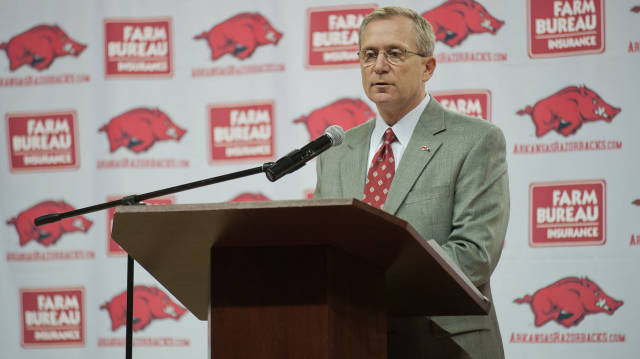 When Arkansas athletics director Jeff Long agreed to replace long-time director of athletics Frank Broyles, the expectations were high, to say the least.
When Arkansas athletics director Jeff Long agreed to replace long-time director of athletics Frank Broyles, the expectations were high, to say the least.
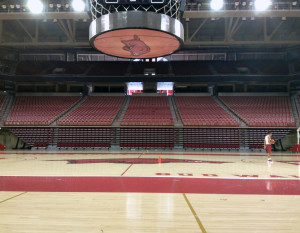
Broyles, also a national champion football coach for the Razorbacks, not only hired numerous coaches, including John McDonnell, who led the Arkansas track and field program to 40 national championships and Nolan Richardson, who guided the Razorbacks basketball team to its only national title, but Broyles also brought some of the nation’s best stadiums and arenas to Fayetteville, as well. He helped lead the expansion of Donald W. Reynolds Razorback Stadium from 51,000 seats to 72,000 and added a 30-foot-by-107-foot SMARTVISION LED screen atop the Broyles Athletic Center in 2001. Additionally, Bud Walton Arena opened in 1993, replacing long-time basketball arena Barnhill Arena, and Baum Stadium debuted in 1996 with Broyles at the helm of the Arkansas athletics program.
Arkansas associate athletics director Kevin Trainor said Long picked up where Broyles left off and has also brought another important focus to the athletics program, however.
“We certainly had a tremendous set of competition facilities, no doubt about it, including some of the best ranked in the country,” Trainor said. “Where we lagged a little behind were in some of the behind-the-scenes areas and preparation areas. Now, with the opening of the football center and the opening of other venues, you’re starting to see the infrastructure of the athletic program begin to build.
“For the student-athletes, where they train, where they work everyday and go to study hall and that sort of thing is really building up. We’re very proud, certainly, and what Coach Broyles did with the competition facilities was outstanding. I think this is just another chapter with that, another step to bring the other facilities and joining facilities up to the standard that we have already set with our competition facilities and at the same time, recognizing that we continue to make changes. You continue to make changes and continue to improve things to keep it one of the best facilities in the country. It’s not just a matter of building it and then letting it sit. You’re always looking for new ways.
“I think Jeff, since he has been here, has certainly done a tremendous job of evaluating the needs of a combined program, evaluating the needs of what areas we needed to deal with first and when you talk about an athletics facilities master plan, not just what we need today, but what we need 10, 15, 30 years down the line, setting up the program to identify how you can have success and keep these great facilities not just for the next decade, but for even more years to come. I think the exciting thing when you start thinking about a long-range plan is beginning to think about what we need to do to stay strong as a program and compete in the most competitive conference in the country.”
Kikko Haydar, a senior guard on the Arkansas basketball team, said Long’s commitment to student-athletes has propelled the Razorbacks to being one of the most overall competitive athletics programs in the nation.
“Jeff Long has done a tremendous job helping Arkansas rise to the top,” Haydar said. “The fundraising for the new facilities and the moves he has made as far as hiring coaches has been exceptional.”
Long became the Arkansas athletics director in 2008, following Broyles’ retirement, and has hired championship coaches, as Broyles did, and given lengthy contract extensions to coaches, as well. Long has also pushed forth several construction and renovation projects, which are all part of a multi-decade, approximately $320 million master plan that he introduced in 2011, including the football operations center, which the team toured on Friday, and three projects that are at the focus of the Never Yield campaign that was introduced at the beginning of July.
Football operations center complete
The first aspect of Long’s master plan was the football operations center, which the team began using Monday, July 22.
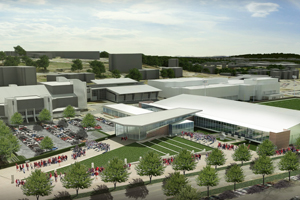
The Fred W. Smith football center, which is named after the chairman of the Donald W. Reynolds Foundation, cost approximately $40 million. The Reynolds Foundation gave a $10 million lead gift as a challenge grant.
“His generosity has once again demonstrated a strong devotion to our mission of winning championships,” Arkansas football coach Bret Bielema said of Smith when his name had been recommended for the naming of the football center. “I am a big believer in preparing student-athletes for football and for life and I am pleased to associate Fred W. Smith’s name with the facility that will amplify our focus in these areas for countless future Razorbacks.”
The Fred W. Smith football center features locker, meeting, training and equipment rooms, coaches’ offices, a players’ lounge, a recruiting reception room and a football museum area.
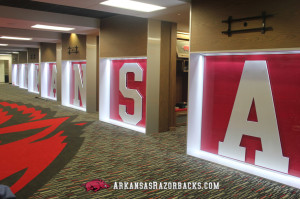
“I believe in player development,” Bielema said. “I believe that a player in year one is going to be a good player but in year four he can be great if he is developed. Not only developed physically, but mentally and socially. Those are three things that go together in a big, big way. That facility is going to allow us to do those things.”
In addition to the football operations center, the Arkansas football team received new practice fields prior to the 2012 season, which are located south of the Willard and Pat Walker Pavilion, where the indoor practice field is located. Arkansas also upgraded its video screen, which is located in the north end zone of Donald W. Reynolds Razorback Stadium.
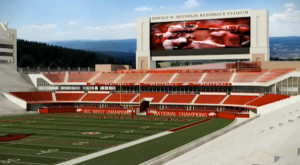
Before the 2012 season began, the display was made into a 16mm video display, which achieved the highest definition standards based on its size. The high definition screen measures 167 feet wide and 38 feet tall and is the second-largest on-campus video display in the country. New LED stadium identification signs and game clocks and play clocks on the north and south end of the stadium were also included in the $4.6 million project.
Donald W. Reynolds Razorback Stadium could be expanding, too. Part of the 2011 master plan was the addition of seats in the north end zone. Long estimated the expansion would add as many as 5,000 seats and would likely cost $78-95 million. A survey was emailed to season ticket holders as part of a cost analysis for the potential project.
#NeverYield
The football operations center has been fully funded for nearly a year and with its completion on Monday, the Arkansas athletic program has moved on to its next projects within the master plan.
On July 1, the U of A officially introduced the Never Yield campaign, which includes a fundraising initiative for three specific construction projects, the student-athlete success center, the basketball practice facility and the baseball and track indoor facility.
“Never Yield is an opportunity to show the rest of the country our desire to compete and win in all aspects of intercollegiate athletics,” Long said when the campaign was introduced. “Our fight song proclaims that ‘Arkansas will never yield,’ and that embodies our approach to achieving success on the athletic fields, in the classroom and in our community.
“Never Yield also represents our program’s unwavering commitment to providing our student-athletes with the facilities and resources they need to reach their fullest potential through intercollegiate athletics. Appropriately, the first initiative of Never Yield is targeted at securing that support.”
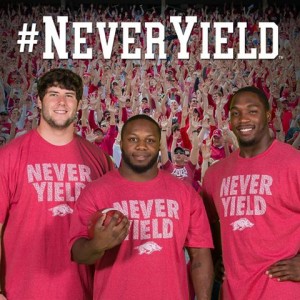
In addition to the push for fundraising, Never Yield offers a chance for fans to unite with this battle cry on social media and includes a push for the inclusion of students as well. Students with the all-access pass, serving as members of the “Hog Trough,” will receive a Never Yield t-shirt and fans can buy the shirt at Hog Heaven or online. Trainor said the phrase as a whole represents the history of the Arkansas athletics program and he thinks fans will embrace it.
“There are other brands across the country, but again, ‘Woo Pig Sooie’ and ‘Go Hogs Go’ will always be a part of what we are doing. But this was unique to fit the social media context of today’s world and also to bring the tradition of what our program has been and kind of bring us into a new chapter in our program, not only athletically, but facility-wise and that sort of thing,” Trainor said. “It just seemed to really embody what our program is all about and the commitment our fans have to making this program successful.
“You look and it really represents our expectation and our commitment in a lot of different areas, so we think it’s something that can be a multipurpose campaign to encompass a lot of different things we are doing as well as something people can latch onto, take pride in and know that we are talking about the University of Arkansas.”
Student-athlete success center
Unlike most of the athletics facilities included in the master plan or even the newly-launched Never Yield campaign, the student-athlete success center will be used by all 19 teams within the Arkansas athletics program.
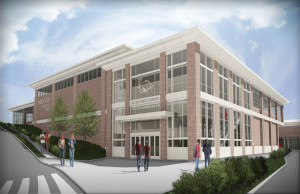
The student-athlete success center is estimated to cost $18-23 million and will be located east of John McDonnell Field and north of Pomfret Hall. It will replace the current Bogle Academic Center, which is located in Donald W. Reynolds Razorback Stadium, and Trainor said this change of venues for the Bogle Academic Center has been a necessary one for a long time.
“When the existing academic center that we are in now was built, it was built for one program — the men’s program at the time,” Trainor said. “And now we have 460 student-athletes, so we don’t have the space or the resources to accommodate the large number of student-athletes for a combined program. The student-athlete success center is something that will not touch just one or two, but will touch all 19 sports and all 460 student-athletes. It will really be a cornerstone of our program and will touch every area and is something that we have needed for quite some time and will continue to enhance what we can do academically and student-athlete development wise.”
The new student-athlete success center will offer multiple learning environments and an academic support program focused on the development of the entire student-athlete, including academic advising, tutoring, character development and financial literacy, according to the Never Yield campaign’s website.
Basketball practice facility
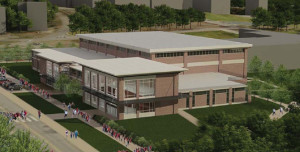
Another facility included in the Never Yield campaign is the basketball practice facility.
While Arkansas is the last member of the Southeastern Conference to build a basketball practice facility, Trainor said both the basketball practice facility and the student-athlete success center give the Razorbacks a chance to remain on the same level with its competition within the league and nationally.
“The addition of the basketball facility would give our student-athletes a place to really develop and refine their skill level,” said Mike Anderson, the Arkansas men’s basketball coach. “Not only do we have one of the top arenas in the country, but with all the amenities of a practice facility, our student-athletes would have access to one of the best training facilities. This complex would also give us the flexibility to schedule our training times around our student-athletes’ class schedules and not have to worry about arena conflicts.”
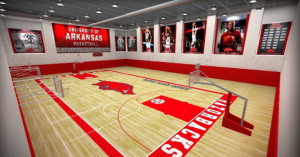
The basketball practice facility is estimated to cost $20-25 million and will be located across from Bud Walton Arena, south of Leroy Pond Road and between Bogle Park and the Gardens. It will feature two full-court gymnasiums, locker rooms for both the men’s and women’s teams, weight rooms and training rooms, coaches’ offices, meeting rooms and a team lounge.
Scotty Thurman, the director of student-athlete development for the Arkansas’ men’s basketball team, played for the Razorbacks for three years in the 1990s and hit a go-ahead 3-point basket with less than a minute left in the Razorbacks’ 76-72 victory over Duke in the 1994 national championship game. He said the basketball practice facility will help both the men’s and women’s programs accomplish more than they already do on a daily basis.
“I think that the practice facility will allow the coaching staff from both women and men’s athletics to be better prepared for the flow of basketball camps, more efficient with practices and workouts, flexibility with recruiting, and it should enhance recruiting,” Thurman said. “It will also allow our student-athletes to be able to work themselves out, without a coach, which is beneficial when a student-athlete wants to shoot or work on ball handling.”
Baseball and track indoor training facility
The third and final facility at the focal point of the Never Yield campaign is the baseball and track indoor training facility. Kinko Constructors Inc., the general contractor for the facility, began site work on it Monday.
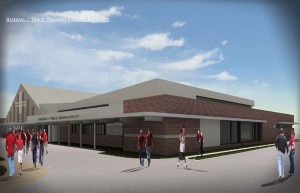
“I think the baseball and indoor track facility will really put us a step ahead of our competition,” Trainor said. “There are some facilities out there, whether a baseball team may use a football facility or another existing facility, but I’m not sure there is any place in the country that will combine baseball and indoor track in the way that this will do.
“It will allow us to host all of the events for track and field on the same campus, whereas right now, we host the throwing events in the Walker Pavilion. But baseball wise, to be able to go inside and take a full infield, to be able to work in those months leading up to the baseball season. Obviously the weather is not always ideal that time of year. So to be able to do that will be a tremendous step forward for, frankly, three of our most nationally competitive programs, when you talk about baseball and men’s and women’s track. They’re already some of the higher achieving programs we have, but this will allow them to maybe take a step ahead of their competition in that area.”
In addition to the Arkansas track and field program’s 41 total National Championships, the Arkansas baseball team has had its fair share of success. The Diamond Hogs have made seven College World Series appearances, including three under current head coach Dave Van Horn. He has also led the Razorbacks to 11 consecutive NCAA Regional appearances.
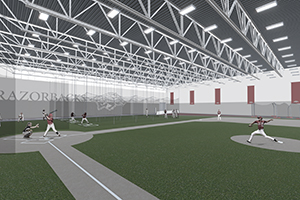
“It would be huge for us,” Van Horn said. “Whenever they talk about the facility, they talk about inclement weather and all that, but we would use that facility every day.
“The work and practice we’d be able to get done in there would be second to none. Then, obviously, the ability to bring recruits in there and show them that facility would really prove to them how important baseball is here at Arkansas.”
The baseball and indoor track training facility is estimated to have a $7.75-9.625 million price tag and will be on the north side of the existing Randal Tyson Track Center.
What’s next?
In addition to the proposed changes for the football program’s facilities and the three facilities that are part of the Never Yield campaign, Long’s master plan features several other projects pertaining to all 19 sports.
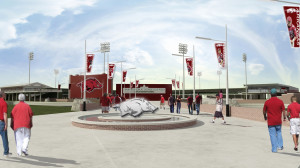
Other proposals within the $320 million master plan include expansions of Bogle Park (softball), Baum Stadium (baseball), John McDonnell Field (outdoor track), the Billingsley Tennis Center, indoor and outdoor swimming, the Smith golf center, improvements to Bud Walton Arena and the building of a 5,000-seat competition venue for gymnastics and volleyball.
During the 2011 press conference in which he revealed the multi-decade master plan, Long said the details of the plan are tentative, but it should help guide the athletics program for the future.
“We have an obligation to plan for the future and the athletic facilities master plan enables us to move forward in the best interests of meeting the needs of our student-athletes, coaches, donors and fans,” he said. “The plan is an ambitious wish list to address facility needs for all 19 of our sports over the next five, 15 and 30 years. It is the next step to build our program and maintain competitiveness in the Southeastern Conference and nationally.”
Arkansas innovating beyond construction
Along with embracing construction to remain competitive within the conference and nationally, the Arkansas athletics department has adapted to the worldwide social media phenomenon.
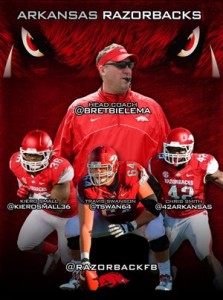
Part of the Never Yield campaign is the use of the hashtag “#NeverYield,” but the Razorbacks have looked to promote fan involvement in other ways, as well.
The Arkansas football team released the cover of its media guide on July 10, announcing it was the first to ever feature Twitter handles of its coach and players. Bielema (@BretBielema), fullback Kiero Small (@KieroSmall36), center Travis Swanson (@Tswan64) and defensive end Chris Smith (@42Arkansas) appear on the cover with their Twitter handles.
“When you are talking about generating interest around the country and of new generations of fans, social media plays such a huge part in that,” Trainor said. “I think if you look at some of the things that we are doing, it is to engage new fans and bring new fans to the program. Just as people that grew up in our state learned about the Razorbacks through coaches’ shows or newspapers or other means, now social media is a huge part of that in delivering news and content, so we want people to be able to connect to our program through social media. So having a strong social media presence for our coaches and our program and our student-athletes is very important as we begin to brand our program, not just statewide and regionally, but nationally as well.”
By Logan Wilson and Calli Berna

